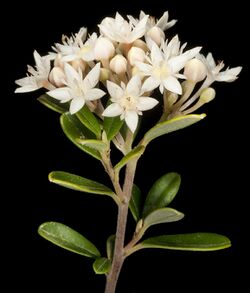Biology:Pomaderris myrtilloides
| Pomaderris myrtilloides | |
|---|---|

| |
| Scientific classification | |
| Kingdom: | Plantae |
| Clade: | Tracheophytes |
| Clade: | Angiosperms |
| Clade: | Eudicots |
| Clade: | Rosids |
| Order: | Rosales |
| Family: | Rhamnaceae |
| Genus: | Pomaderris |
| Species: | P. myrtilloides
|
| Binomial name | |
| Pomaderris myrtilloides Fenzl[1]
| |
Pomaderris myrtilloides is a species of flowering plant in the family Rhamnaceae and is endemic to near-coastal areas of southern Western Australia. It is an erect shrub with many branches, narrowly egg-shaped elliptic or wedge-shaped leaves with the narrower end towards the base, and cream-coloured to pale pink flowers.
Description
Pomaderris myrtilloides is an erect shrub that typically grows to a height of 0.3–2 m (1 ft 0 in–6 ft 7 in). The leaves are elliptic, wedge-shaped, or egg-shaped with the narrower end towards the base, 10–26 mm (0.39–1.02 in) long and 7–15 mm (0.28–0.59 in) wide with narrowly triangular stipules 1–4 mm (0.039–0.157 in) long at the base but that fall off as the leaf develops. The upper surface of the leaves is more or less glabrous and the lower surface is covered with minute, star-shaped hairs. The flowers are cream-coloured to pale pink and are borne in groups 15–35 mm (0.59–1.38 in) wide, each flower on a pedicel 3–8 mm (0.12–0.31 in) long. The sepals are 2–3 mm (0.079–0.118 in) long and the petals narrowly lance-shaped and 1.3–2 mm (0.051–0.079 in) long. Flowering mainly occurs from July to October and the fruit is an oval capsule 4.0–4.5 mm (0.16–0.18 in) long.[2][3][4]
Taxonomy
Pomaderris myrtilloides was first formally described in 1837 by Eduard Fenzl in Enumeratio plantarum quas in Novae Hollandiae ora austro-occidentali ad fluvium Cygnorum et in sinu Regis Georgii collegit Carolus Liber Baro de Hügel from specimens collected by Ferdinand Bauer.[5] The specific epithet (myrtilloides) means "myrtillus-like", referring to a similarity to Vaccinium myrtillus.[6]
Distribution and habitat
This pomaderris grows in near-coastal vegetation on limestone ridges or deep sand on dunes between Albany and Eucla in the south of Western Australia.[3][4]
Conservation status
Pomaderris myrtilloides is listed as "not threatened" by the Government of Western Australia Department of Biodiversity, Conservation and Attractions.[3]
References
- ↑ "Pomaderris myrtilloides". Australian Plant Census. https://biodiversity.org.au/nsl/services/apc-format/display/112120. Retrieved 14 March 2022.
- ↑ Walsh, Neville G. (1994). "Pomaderris brevifolia (Rhamnaceae), a new species from south-west Western Australia". Muelleria 8 (2): 110. https://www.biodiversitylibrary.org/item/209968#page/16/mode/1up. Retrieved 14 March 2022.
- ↑ 3.0 3.1 3.2 "Pomaderris myrtilloides". FloraBase. Western Australian Government Department of Parks and Wildlife. https://florabase.dpaw.wa.gov.au/browse/profile/4818.
- ↑ 4.0 4.1 Rye, Barbara L. (1996). "A synopsis of the genera Pomaderris, Siegfriedia, Spyridium and Trymalium (Rhamnaceae) in Western Australia". Nuytsia 11 (1): 114. https://www.biodiversitylibrary.org/item/225336#page/120/mode/1up. Retrieved 14 March 2022.
- ↑ "Pomaderris myrtilloides". Australian Plant Name Index. https://biodiversity.org.au/nsl/services/rest/instance/apni/544974. Retrieved 14 March 2022.
- ↑ Sharr, Francis Aubi; George, Alex (2019). Western Australian Plant Names and Their Meanings (3rd ed.). Kardinya, WA: Four Gables Press. p. 258. ISBN 9780958034180.
Wikidata ☰ Q17250765 entry
 |

